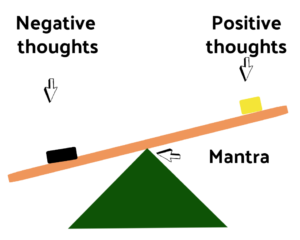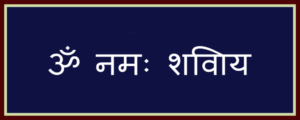Traditional mantra is a means of getting into meditation. Mantra is not a long phrase. The one illustrated here is what my lineage feels at home with – Om Namah Shivaya. Literally it translates to Om (universal self) I honour Shiva. The deeper meaning is to honour and cultivate the sense of the oneness of universal being, which includes identically the one reading this… and the one writing it. (Contemplate it!)
Some regard it simply as an invocation, but that is primitive compared with the deeper contemplation.
How to practice mantra
There are two ways of practising mantra. Firstly, you can practise it as a concentration to get to a still state of meditation; secondly, you can practise it all of the time! so that it becomes the default thought that your mind returns to all the time, rather than busying itself constantly with the myriad aimless thoughts that run through anyone’s mind.
Japa: Repetition
This is the first way of practising mantra. Japa is the repetition of the mantra. When you sit to meditate, until your mind becomes quiet, repeat your mantra silently, once on each breath. Don’t try to analyze the mantra or its effects… just hold it in your mind and repeat it mentally with each breath. Soon your mind will calm down and you will feel like slipping into stillness. Let that happen; let go of the mantra and settle into stillness.
But we slip out of stillness and into thinking or daydreaming, and it happens so easily and subtly that it may be a little while before you notice what has happened. Don’t flog yourself… simply take up the mantra again…and again… and again… Even if you never slipped into stillness, holding the concentration of the mantra is excellent practice.
The holding of the mantra does bring an understanding with it, deeper than conceptual reasoning about it, and it keeps the mind focused. Eventually, stillness follows.
Ajapa-japa: Non-repetition Repetition
Have you ever noticed how your mind tells you the same old thing over and over? A lot of times it might be about what should have happened and that what did happen was awful. Or it might go over and over an argument, each time getting better at how right you are and how wrong the other person was. Another constantly reinforced thought is I am Anne, (or Anthony, or John or Jenny)…. and the comforting stories that support your idea of being that person. Even if other people don’t particularly like that person!
The ancient meditators figured out that if we can and do obsess about things, it is because thoughts, constantly repeated, hold them in place. So why not put a thought there that stops it? A mantra, of course. One that could fill the mind, so that instead of it returning to its well-beaten path of thought-tracks, it would come to something new – a quietness and peacefulness of mind.
But there is something that I would like you to notice clearly . It is this: Mantra is not positive affirmation.
MANTRA IS NOT POSITIVE AFFIRMATION
When you see that mantra can replace negative outdated thinking with something much  healthier, you might suppose that mantra is just an antiquated name for positive thinking. NO! Mantra takes you to a neutral place in the mind – the state just before the stillness of meditation.
healthier, you might suppose that mantra is just an antiquated name for positive thinking. NO! Mantra takes you to a neutral place in the mind – the state just before the stillness of meditation.
This way it does not engage in goal-setting or any sort of drive for success. Mantra does employ a thought-phrase – but it is one that takes us to neutral, not positive and not negative.
Think of the mind like a see-saw. It is always either up or down. But at the fulcrum there’s no partaking of the ups and downs of the plank. The fulcrum is where the mantra takes us. You don’t buy into negative thoughts, and you don’t buy into positive thoughts, either.
Gandhi
Did you see the film “Gandhi” some years back? Did you notice that when he was dying, there were rosy clouds in the sky? And they had him say, “Oh God, oh God, oh God”.
That didn’t really work. There was no reason why a dying man would see a rosy sunset. And English speakers only ever say “Oh God” in a negative way, a cry of apprehension. It may have been the best they could do to give the sense that, actually, he was saying his mantra, probably Hare Ram. It more or less translates to “oh, God”, but not in the English way.
It seems that when his mind had something to do, such as planning the next move in his aim to get the British out of India, he used his mind for thinking, and strategy, and reasoning. That is the great faculty of the mind.
When he was not doing that, he did not fill his mind with negative thoughts of hatred and vindictiveness and judgement. Nor did he fill it with positive affirmations about his goals or his cause or his own rightfulness.
He filled it with his mantra, and was at peace. In a non-cognitive way, the mantra did also cultivate the sense of the presence of Rama, without him being busy trying to achieve it. At the time of maximum stress, he did not have to think about his mantra, or remember it as a tool or an affirmation – it simply was the default state of his mind.
Not a bad way to go if you are being murdered. And that’s ajapa-japa, because you can’t wait for a stressed out state and then hope that the mantra will work. It has to be practiced just about with every breath, not just when you are about to meditate.
So what is your mantra?
These days, you might as well choose one yourself. As this topic is Traditional Mantra, you might like to try either of these: Om Namah Shivaya or So-ham
Om Namah Shivaya
In Shaivism (the tradition that I am from), there’s Shiva and there’s jiva – Shiva being big universal consciousness, and jiva being little individual consciousness, with the recognition that both Shiva and jiva are one and the same. That’s a bit of a mindboggler.
Whenever you are using Om Namah Shivaya as a mantra, it would have a twofold purpose: one of slowing the mind to get into meditation – having a single thought to focus on to get the mind into stillness; the other is contemplative – just hold it without analysing.
Sometime when you really are thinking, whenever your mind is drawn to it, consider how it could possibly be that a single individual is identical with Universal being – without that being a narcissistic statement?
For the individual that’s big, it is existential, it is spiritual, and oddly ends up being about reality itself. It broadens the mind to being able to accept the diversity of reality, the comforts and discomforts of life, the noble and the ignoble. To be a bit Zennish, we become ok with the is-ness of life.
So Ham ( सो ऽहम् )
Pronounced so-hum, it is another small and well-known Sanskrit mantra.
It means I am(that One) and it imitates the sound of the breath. Whether you breathe in and say So and breathe out and say Ham or vice versa, it doesn’t matter, as either way it imitates the sound of the breath. Again the point is to slow the mind down until stillness comes upon you.
The words do mean I am (that One), so when you do think about this Sanskrit mantra, as opposed to doing japa, ask yourself, “Well, even the breath says I am – what is it that I am? Start putting your regular tags on I am and see where they lead you. I am… Maryanne… but as a newborn I had no name…I am Australian… but as a foetus I had no nationality… I am a mother…. but my children came at a certain point and then grow into themselves… how could my being (am-ness, or that-ness, or one-ness) be squeezed into any of these labels? But what am I if the whole of what can be said about it is I am…That????
The grammar of I am that
A curious grammatical fact is that “is”, “am”, “are” – that is, the verb to be – confers identity between the two sides. English has blurred that identity-making role, so we use the one verb, “is” (and all its forms, like are and will be), for transitory and non-identical things as well as for showing that two things are identical.
But Sanskrit (and also Gaelic) has two forms of the word “is” – one where the identity on one side of “is” directly equates with the other side (In Sanskrit, it is called a “copula”, a coupling phrase) and another for passing states.
The copula talks about the identity of two things, eg “Water is H2O”.
“He’s cold” refers to a passing state, generally using an adjective to describe something. In Sanskrit the other verb for “is” would be used. If you want to confer a direct equation between two things, you have to be very precise in the way you say it.
So it can’t be the same sort of phrase as, I am angry, I’m Australian, I’m hungry, I’m in IT, I’m wiser than I used to be, you’re beautiful, you’re mad. They are passing states.
If I am …that, my whole identity is…? “That.” What? Well, that is the huge undefinable, because anything added would only be conceptual, a word or an idea, not an identity.
Remember then that mantras are not positive affirmations. like “I’m worth it” or “Every day I reach my goal”. All of those positive affirmations aim at strengthening an ego state, which is always in transition, a passing state, trivialising the I-Am.
The neutral space of the mantra manages very neatly to take you into something much deeper than an ego goal or a nice label.
And also…
Sanskrit mantras, although they have meaningful content, can be used simply as something to bring your mind to attention, saving it from wandering into all of the other things that attract it without reinforcing ego states at all. But there are deeper aspects to the Sanskrit mantras which are unlikely to be in the phrases people make up for themselves, as in the modern way, and not often either in the prayers from various religious groups.
In a short while I will post a discussion about the benefits (different but useful) of mantra in the modern era.

